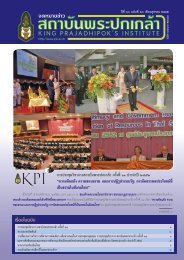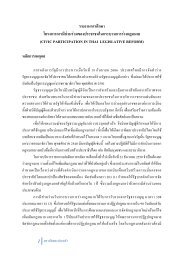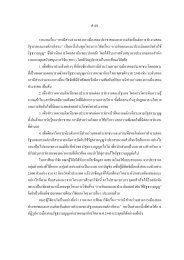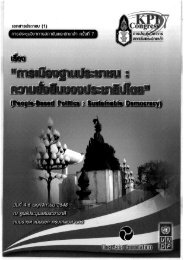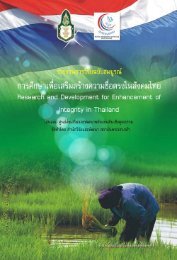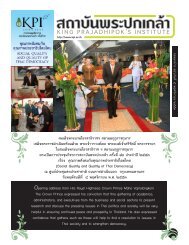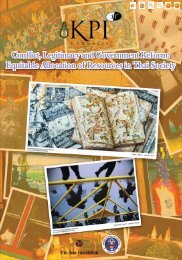SUFFiciENcy EcONOMy ANd GRASSROOtS DEvElOPMENt
SUFFiciENcy EcONOMy ANd GRASSROOtS DEvElOPMENt
SUFFiciENcy EcONOMy ANd GRASSROOtS DEvElOPMENt
Create successful ePaper yourself
Turn your PDF publications into a flip-book with our unique Google optimized e-Paper software.
The Meaning of Sufficiency Economy <br />
International Conference<br />
295<br />
annum in H.D.Kote and K.R.Nagar, respectively. Another key financial asset was<br />
the insurance premium of the household members. In the sample, 8.2 and 7.5 per<br />
cent of the members in H.D.Kote and K.R.Nagar had the insurance cover (policy)<br />
before their memberships in microfinance programme. However, in the post<br />
microfinance programme, 100 and 43.4 per cent of the members in H.D.Kote and<br />
K.R.Nagar were having the insurance coverage.<br />
Table - 8 Number of Households Possessing Various Types of Physical Assets<br />
Number of Households<br />
Types of Physical<br />
assets<br />
H.D.Kote K.R.Nagar Total (N=401)<br />
Yes No Yes No Yes No<br />
Land 98 (61.6) 61 (38.4) 64 (40.3) 95 (59.7) 162 (50.9) 156 (49.1)<br />
Livestock 94 (59.1) 65 (40.9) 79 (49.7) 80 (50.3) 173 (54.4) 145 (45.6)<br />
Electronics 139 (87.4) 20 (12.6) 85 (53.5) 74 (46.5) 224 (70.4) 94 (29.6)<br />
Vehicles 19 (12.0) 140 (80.0) 4 (2.5) 155 (97.5) 23 (7.2) 295 (92.8)<br />
Tools and Equipments 10 (6.3) 149 (93.7) 5 (3.1) 154 (96.9) 15 (4.7) 303 (95.3)<br />
Others <br />
(gold, petty shop)<br />
84 (52.8) 75 (47.2) 40 (25.2) 119 (74.8) 124 (39) 194 (61)<br />
Note: Figures in parenthesis denote percentage to the total number of households<br />
Source: Primary Survey.<br />
<br />
Major Findings of the Study<br />
Based on the analysis and discussion the following findings have been drawn.<br />
1. The occupation status of the respondents reveal that, out of 401 members<br />
agricultural labours with/ without animal husbandry activities form the<br />
single largest majority (81.79%). It is also found that 92% of the members<br />
are Hindus followed by 6.48% of Christians.<br />
2. Initially the groups which emerged naturally consisted of members who<br />
came forward voluntarily. Invariably the poorest people were diffident and<br />
unwilling to join the groups. But on seeing the successful experience of the<br />
other members the poor agreed to form groups. Keeping the criteria of<br />
family income of Rs.11,000/- as the cut off point, it is found that 54.11% of<br />
the total members are below the poverty line. The poorest with annual<br />
income below Rs.6,000/- are found more among the group members of<br />
MYRADA (21.05%). Vikasana (18%) and Pragathi (17.78%).



